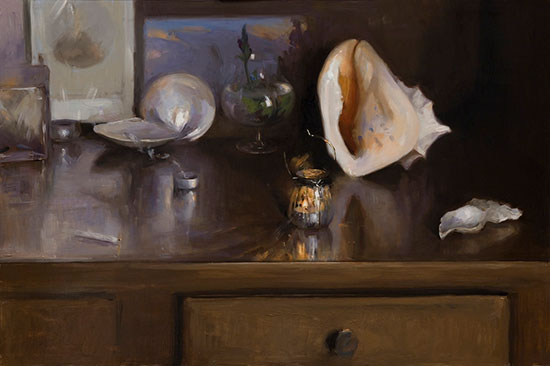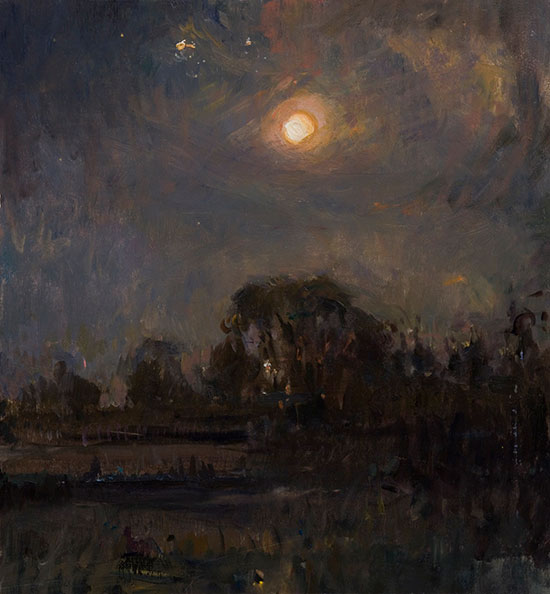Realism that comes with a whiff of fresh paint has its job cut out for it in an abstract era. The impressive strength of the two-artist exhibition at Sag Harbor’s Grenning Gallery, a bastion of traditional genres, shows the way that impromptu gestures can raise realism to the level of poetry while evading the possible trap of remaining prosaically photographic.
“Ramiro ┃Sanchez” presents a wide-ranging if understated conversation between husband and wife Melissa Franklin Sanchez and Ramiro Sanchez. The two share a studio in Florence and are annual visitors to the East End, where they paint seascapes and compelling portraits, often on commission.
Angel Ramiro Sanchez, originally from Maracaibo, Venezuela, has been on a fast track to artistic achievement from an early age. A musical prodigy, he was awarded a full ride at the age of 6 to study viola at the Instituto the Niños Cantores del Zulia. He was 14 when he started his five-year apprenticeship with the realist painter, Abdon J. Romero, known for his murals in churches. In 1993 he arrived in Italy to take courses simultaneously at the Accademia di Belle Arti and at Florence Academy, where he is now the director of the Advanced Painting Program.
Melissa Franklin Sanchez is Ramiro’s English-born wife, raised in Warwickshire. A ballerina who came to the visual arts via stage design, she completed the foundation course at the Slade School in London and then chose the Florence Academy for its rigorous three-year program in realism and figural painting. Her broad-based liberal arts background and her specialized training in technique complement each other in intellectually layered works such as Collecting Memories, a large vertical interior of her studio in Italy.
.

"Collecting Memories" by Melissa Franklin Sanchez, 2016. Oil on aluminum, 30 x 40 inches. Courtesy of Grenning Gallery.
.
I love a painting that makes the viewer work hard, and Collecting Memories puts the viewer to the test. Really three paintings in one, this pensive view takes its place in a rich tradition shared by such distinguished predecessors as Gerome, Matisse, Braque, Picasso, and Giacometti. (A major exhibition devoted to the theme as interpreted by these artists and others held at Gagosian Gallery was reviewed here.)
The working space as subject is the perfect cover for another agenda, because this painting is also a cunningly indirect self-portrait. The ballet shoes pinned to the wall point to her dance background (they were actually a ceramic knick-knack given to her by her mother). A picture of a favorite dog and postcards of favorite works collected from the museums she has visited on her travels are all sources of inspiration. The still life and self-portrait are complemented by a small landscape, a painting within the painting that captures the bright reflection in the glass of a breakfront case of a tree and street outside.
Surrounded by the silvery surfaces of shells, polished metal and glass in her still lifes, certain colors burn hotter than others, such as the cranberry red of the glass vase or the burnished pink-orange inside of a conch in Collecting Memories, or the glowing ember at the tip of a candle wick in Remember Me, an elegiac still life. An artist’s statement on what subject matter attracts her has a wistful quality: “I am naturally drawn to aspects of life that transcend time, moments that could have been yesterday, today or perhaps tomorrow.”
.

"Remember Me" by Melissa Franklin Sanchez, 2016. Oil on aluminum, 19.6 x 29.5 inches. Courtesy of Grenning Gallery.
.
The artistic to and fro between the couple in the Grenning exhibition yields some enriching connections. One of the most impressive details in Ramiro’s deceptively straightforward Allegory of Painting is a wooden palette held by the young woman at a slight angle to the plane of the canvas. Across the room, a wooden palette hangs on the studio wall in Collecting Memories. They are not the same object (she used her childhood palette) but the thread is tight between a strong image of a young woman taking up the brush and the autobiographical portrait of an artist’s studio.
.

"Allegory of Painting" by Ramiro, 2016. Oil on canvas, 41.3 x 37.4 inches. Courtesy of Grenning Gallery.
.
The catch in Ramiro’s painting is that the young woman is staring not at the viewer but at a mirror, concentrating on her own delicate features so she can paint a self-portrait. Art history offers many variations on the theme of the Allegory of Painting, one of the most serious works in the show. My favorite is Vermeer’s sumptuously attired young lady holding a brass trumpet and large yellow folio, gazing demurely downward (or is she fatigued?) as the artist seated at the easel roughs out the leaves of her laurel crown in blue on his just-started canvas.
The woman in the Vermeer is decidedly a model cast in her role by a male employer, which is a far cry from what Ramiro is after in his own bold reading of the theme. For him, the nude figure whose frank gaze seems to challenge our own has stepped right out of the Baroque fantasy behind her to forge an independent existence. The background, incidentally, is adapted from Veronese, and the two figures clasping hands behind the woman are emblems of the arts embracing. Ramiro drives the eye to detail, in this case it is the slender green tip of the brush in her hand.
Many realist painters are surprisingly proud of their abstract passages, often found in the background, where they cut loose with the brush and palette. The highlight of the show from the point of view of narrative drama is Ramiro’s most eccentric painting. Allegory of Chopin: Nocturne—hanging by a thickly painted landscape titled simply Nocturne—uses a nude, her mouth open as though belting out a bel canto aria, to delve the emotional depths of Chopin’s brooding solo piano compositions. This is true to the composer’s biography, as Chopin sought to make his legato as fluid as operatic singing (the real meaning of the dynamic indication cantabile).
.

"Allegory of Chopin (Nocturne)" by Ramiro, 2016. Oil on canvas, 29.5 x 41.5 inches. Courtesy of Grenning Gallery.
.

"Nocturne" by Ramiro, 2015. Oil, 15 x 13.5 inches. Courtesy of Grenning Gallery.
.
The painting unlocks a panoply of associations between music and painting, including a marvelous chapter in cultural history that stars Chopin in Paris, where he made his reputation as a virtuoso, in the frequent company of his dear friends Eugene Delacroix, Franz Liszt (they played duets, with Chopin taking the bass) and his lover, the novelist George Sand. On carriage rides home from salons where Liszt and Chopin would improvise (think of the Impromptus) they would discuss with Delacroix the meanings of color harmony and dissonance to their arts.
I admire the musical Ramiro’s reading of Chopin’s music (even the off-center composition brings to mind the importance of rubato, or playing slightly off the beat, to interpreting the Nocturnes) as well as the ways in which this bold painting resembles the most robust nudes of Delacroix. This extends to those flashes of orange-red that cut across not just this but some of the other paintings in the show.
In his eulogy for Delacroix the critic Theophile Sylvestre catches some of the tempestuous quality of Ramiro: “He had a sun in his head and storms in his heart and for 40 years played upon the keyboard of human passions and his brush — grandiose, terrible, or suave—passed from saints to warriors, from warriors to lovers, from lovers to tigers, and from tigers to flowers.”
_________________________
BASIC FACTS: “Ramiro | Sanchez” is on view August 27 to September 25, 2016, at the Grenning Gallery, 17 Washington Street, Sag Harbor, NY 11963. www.Grenninggallery.com.
_________________________
Copyright 2016 Hamptons Art Hub LLC. All rights reserved.
